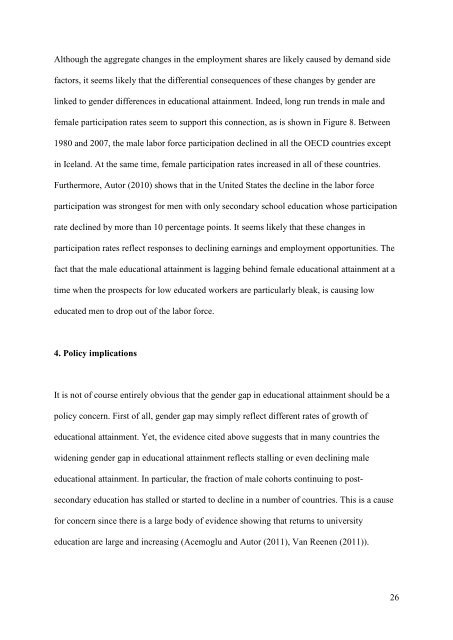Gender Differences in Education Tuomas Pekkarinen - Index of - IZA
Gender Differences in Education Tuomas Pekkarinen - Index of - IZA
Gender Differences in Education Tuomas Pekkarinen - Index of - IZA
You also want an ePaper? Increase the reach of your titles
YUMPU automatically turns print PDFs into web optimized ePapers that Google loves.
Although the aggregate changes <strong>in</strong> the employment shares are likely caused by demand side<br />
factors, it seems likely that the differential consequences <strong>of</strong> these changes by gender are<br />
l<strong>in</strong>ked to gender differences <strong>in</strong> educational atta<strong>in</strong>ment. Indeed, long run trends <strong>in</strong> male and<br />
female participation rates seem to support this connection, as is shown <strong>in</strong> Figure 8. Between<br />
1980 and 2007, the male labor force participation decl<strong>in</strong>ed <strong>in</strong> all the OECD countries except<br />
<strong>in</strong> Iceland. At the same time, female participation rates <strong>in</strong>creased <strong>in</strong> all <strong>of</strong> these countries.<br />
Furthermore, Autor (2010) shows that <strong>in</strong> the United States the decl<strong>in</strong>e <strong>in</strong> the labor force<br />
participation was strongest for men with only secondary school education whose participation<br />
rate decl<strong>in</strong>ed by more than 10 percentage po<strong>in</strong>ts. It seems likely that these changes <strong>in</strong><br />
participation rates reflect responses to decl<strong>in</strong><strong>in</strong>g earn<strong>in</strong>gs and employment opportunities. The<br />
fact that the male educational atta<strong>in</strong>ment is lagg<strong>in</strong>g beh<strong>in</strong>d female educational atta<strong>in</strong>ment at a<br />
time when the prospects for low educated workers are particularly bleak, is caus<strong>in</strong>g low<br />
educated men to drop out <strong>of</strong> the labor force.<br />
4. Policy implications<br />
It is not <strong>of</strong> course entirely obvious that the gender gap <strong>in</strong> educational atta<strong>in</strong>ment should be a<br />
policy concern. First <strong>of</strong> all, gender gap may simply reflect different rates <strong>of</strong> growth <strong>of</strong><br />
educational atta<strong>in</strong>ment. Yet, the evidence cited above suggests that <strong>in</strong> many countries the<br />
widen<strong>in</strong>g gender gap <strong>in</strong> educational atta<strong>in</strong>ment reflects stall<strong>in</strong>g or even decl<strong>in</strong><strong>in</strong>g male<br />
educational atta<strong>in</strong>ment. In particular, the fraction <strong>of</strong> male cohorts cont<strong>in</strong>u<strong>in</strong>g to post-<br />
secondary education has stalled or started to decl<strong>in</strong>e <strong>in</strong> a number <strong>of</strong> countries. This is a cause<br />
for concern s<strong>in</strong>ce there is a large body <strong>of</strong> evidence show<strong>in</strong>g that returns to university<br />
education are large and <strong>in</strong>creas<strong>in</strong>g (Acemoglu and Autor (2011), Van Reenen (2011)).<br />
26
















